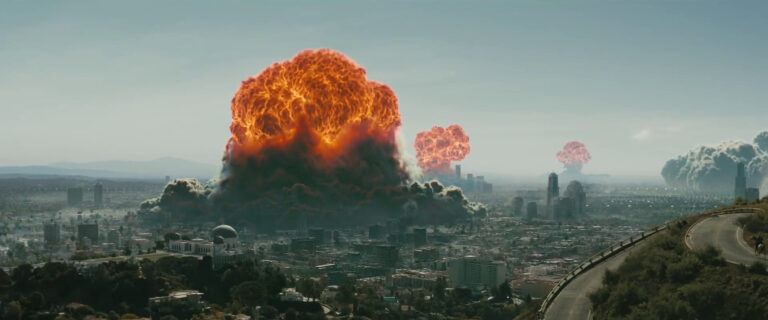The 2024 Total Solar Eclipse is coming to the United States! The next Total Solar Eclipse viewable from the lower 48 will be on August 12, 2045! Yeah that’s a hair over 21 years from now.
In this article I hope to bring you some interesting information for both education and entertainment purposes. Be sure to check the end of this article for sources and other links for more information. The countdown below is when it begins where I will be filming.
When is the 2024 Solar Eclipse?
The 2024 Total Solar Eclipse will occur on April 8, 2024 beginning in Texas and moving in a northeastern direction. For the lower 48 United States, partial begins at 12:10:24 pm CDT and ends at 3:41:03 pm CDT. That’s Texas to Maine in under four hours!

It is estimated that around 43,800,000 people are in the Path of Totality. That might seem like a lot but that’s only about 0.55% of Earth’s population!
If you can’t make it to a viewing location within the path of totality, fear not – I will be (attempting!) to livestream the event with multiple angles including the landscape going dark as well as a telescopic view of the sun with a solar filter as it becomes obscured by the moon!
IMPORTANT! Be sure to subscribe to the Youtube channel and enable notifications so you don’t miss it!
What is an eclipse?
An eclipse is an astronomical event that occurs when an astronomical object or spacecraft is temporarily obscured by passing into the shadow of another body or by having another body pass between it and the viewer.
The term “eclipse” is derived from the ancient Greek noun ἔκλειψις (ékleipsis), which means “the abandonment”, “the downfall”, or “the darkening of a heavenly body”, which is derived from the verb ἐκλείπω (ekleípō) which means “to abandon”, “to darken”, or “to cease to exist.”
To us Earthlings, our observed eclipses involve the Sun, Earth, and its Moon. Our moon. The moon… You know what I mean. An eclipse involving the Sun, Earth, and Moon can occur only when they are nearly in a straight line, allowing one to be hidden behind another, viewed from the third (that’s us, on Earth).
A Solar Eclipse (Sun-Moon-Earth) is when the moon passes between the Sun and Earth.
A Lunar Eclipse (Sun-Earth-Moon) is when the Earth passes between the Sun and the Moon.
Types of Solar Eclipses

Total Eclipse: when the observer is within the umbra.
Annular Eclipse: when the observer is within the antumbra.
Partial Eclipse: when the observer is within the penumbra.
Hybrid Eclipse: shifts between a total and annular eclipse.
- The umbra (Latin for “shadow”), within which the object completely covers the light source. For the Sun, this light source is the photosphere.
- The antumbra (from Latin ante, “before, in front of”, plus umbra) extending beyond the tip of the umbra, within which the object is completely in front of the light source but too small to completely cover it.
- The penumbra (from the Latin paene, “almost, nearly”, plus umbra), within which the object is only partially in front of the light source.
Types of Lunar Eclipses
Penumbral: when part or all of the Moon passes into the Earth’s penumbra.
Partial: when the Moon crosses partially into the Earth’s umbra.
Total: when the Moon crosses entirely into the Earth’s umbra.

Total lunar eclipses pass through all three phases. Even during a total lunar eclipse, however, the Moon is not completely dark. Sunlight refracted through the Earth’s atmosphere enters the umbra and provides a faint illumination. Much as in a sunset, the atmosphere tends to more strongly scatter light with shorter wavelengths, so the illumination of the Moon by refracted light has a red hue,[17] thus the phrase ‘Blood Moon’ is often found in descriptions of such lunar events as far back as eclipses are recorded.
How do you View an Eclipse?
DO NOT LOOK AT AN ECLIPSE WITHOUT PROPER PROTECTION!
You can and will cause irreversible damage to your eyes, possibly go blind and it will also hurt the whole time you are going blind. This is serious.
Except during the brief total phase of a total solar eclipse, when the Moon completely blocks the Sun’s bright face, it is not safe to look directly at the Sun without specialized eye protection for solar viewing.
Viewing any part of the bright Sun through a camera lens, binoculars, or a telescope without a special-purpose solar filter secured over the front of the optics will instantly cause severe eye injury.
When watching the partial phases of the solar eclipse directly with your eyes, which happens before and after totality, you must look through safe solar viewing glasses (“eclipse glasses”) or a safe handheld solar viewer at all times. Eclipse glasses are NOT regular sunglasses; regular sunglasses, no matter how dark, are not safe for viewing the Sun. Safe solar viewers are thousands of times darker and ought to comply with the ISO 12312-2 international standard.
I will be using these from Amazon:
- ▶ Confidence in Viewing – Our Solar Eclipse Viewing Glasses are safe for Direct Sun Observation and are meticulously cra…
- ▶ Exceptional Eye Protection – Our eclipse glasses are CE and ISO Certified For Direct Sun Viewing, independently tested…
- ▶ Bonus Smartphone Photo Filter – Each pack includes 1 Solar Imaging Enhancing Photo Lens to turn your smartphone camera…


Solar Eclipse Glasses ISO 12312-2 (5 Pack)
$15.99 Our eclipse glasses are CE and ISO Certified For Direct Sun Viewing, independently tested, and verified by POCE Technology Laboratories under the most current standard ISO 12312-2:2015(E) for filters for direct observation of the sun. Watch the total solar eclipse with absolute confidence in your eye safety.
Whether you choose these or other eclipse-viewing glasses, research them and understand you’re using at your own risk. More information: https://eclipse.aas.org/eye-safety
Where can I See the Eclipse?
For us in North-Eastern Louisiana (NELA), we will only see a Partial Solar Eclipse, with about 95% obscuration. Along I-20, the Path of Totality will stretch from Tyler, TX to just west of the DFW area. If you want to travel North, you can see the full Total Solar Eclipse in some Arkansas cities like Mena, Hot Springs, Little Rock, Russellville, and Mountain View, to name a few.
Check the end of this article where I’ve included links for interactive maps and more information.
Bonus Eclipse?!
That’s right! A Solar Eclipse always occurs about two weeks before or after a Lunar Eclipse. On Sunday, March 24, 2024, we will get our first eclipse of the year – a penumbral lunar eclipse.
| 2024 PENUMBRAL LUNAR ECLIPSE | |
|---|---|
| Begins: | Sun, Mar 24, 2024 at 11:53 pm |
| Maximum: | Mon, Mar 25, 2024 at 2:12 am |
| Ends: | Mon, Mar 25, 2024 at 4:32 am |
| Duration: | 4 hours, 39 minutes |
A penumbral lunar eclipse takes place when the Moon moves through the faint, outer part of Earth’s shadow, the penumbra. This type of eclipse is not as dramatic as other types of lunar eclipses and is often mistaken for a regular Full Moon.
Because Earth’s penumbral shadow is light, it can be hard to spot as it moves across the face of the Moon. The best time to try and catch it is around maximum eclipse, when one edge of the Moon may appear slightly darker than the other.
If a person was standing on the Moon’s surface during a penumbral lunar eclipse, they would see Earth block out some—but not all—of the Sun. (From their perspective on the Moon, they would see a partial solar eclipse.)
Livestream
I’m going to attempt to livestream the totality part of the eclipse from a camping location in Northern Arkansas. It should start 7 minutes before totality, but I may change that as we get closer and I do more research.
| 2024 TOTAL SOLAR ECLIPSE LIVESTREAM TIMING & STATISTICS | |
|---|---|
| Obscuration | 100% |
| Duration: | 2h, 36m, 47s |
| Totality Duration: | 2m, 37s |
| Partial Begins: | Apr 8 at 12:35:32 pm |
| Full Begins: | Apr 8 at 1:52:56 pm |
| Maximum: | Apr 8 at 1:54:15 pm |
| Full Ends: | Apr 8 at 1:55:33 pm |
| Partial Ends: | Apr 8 at 3:12:19 pm |
Thank You!
If you made it this far, you rock! I’m new at writing articles, blogging, etc. Yes, there will be errors. Yes, I am learning as I go. As always, I’m open to constructive-criticism, as long as it comes from a good place!
I will be updating this article as I discover more information worth sharing and will be posting those updates to the Wade’s World Facebook Page, so be sure to Like & Follow for updates!
Thank you so much for spending your time here. I hope you were entertained and/or learned something!
More Resources
Maps – Static & Interactive:
- https://go.nasa.gov/EclipseExplorer (interactive)
- https://www.timeanddate.com/eclipse/map/2024-april-8 (interactive)
- https://nationaleclipse.com/maps.html (static)
General Information:





